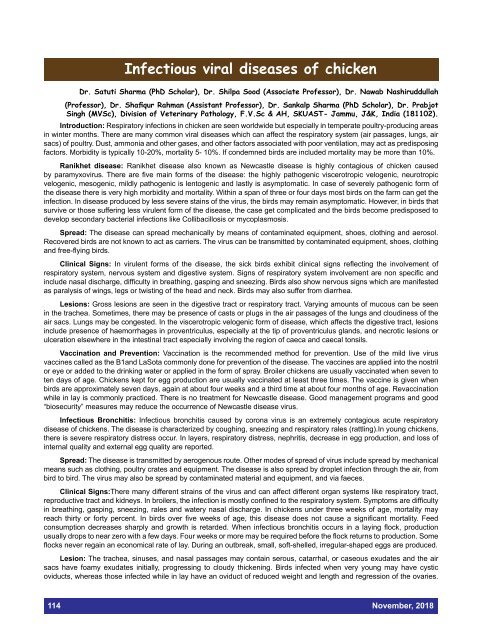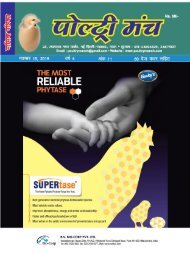November 2018 Punch PDF
Create successful ePaper yourself
Turn your PDF publications into a flip-book with our unique Google optimized e-Paper software.
Infectious viral diseases of chicken<br />
Dr. Satuti Sharma (PhD Scholar), Dr. Shilpa Sood (Associate Professor), Dr. Nawab Nashiruddullah<br />
(Professor), Dr. Shafiqur Rahman (Assistant Professor), Dr. Sankalp Sharma (PhD Scholar), Dr. Prabjot<br />
Singh (MVSc), Division of Veterinary Pathology, F.V.Sc & AH, SKUAST- Jammu, J&K, India (181102).<br />
Introduction: Respiratory infections in chicken are seen worldwide but especially in temperate poultry-producing areas<br />
in winter months. There are many common viral diseases which can affect the respiratory system (air passages, lungs, air<br />
sacs) of poultry. Dust, ammonia and other gases, and other factors associated with poor ventilation, may act as predisposing<br />
factors. Morbidity is typically 10-20%, mortality 5- 10%. If condemned birds are included mortality may be more than 10%.<br />
Ranikhet disease: Ranikhet disease also known as Newcastle disease is highly contagious of chicken caused<br />
by paramyxovirus. There are five main forms of the disease: the highly pathogenic viscerotropic velogenic, neurotropic<br />
velogenic, mesogenic, mildly pathogenic is lentogenic and lastly is asymptomatic. In case of severely pathogenic form of<br />
the disease there is very high morbidity and mortality. Within a span of three or four days most birds on the farm can get the<br />
infection. In disease produced by less severe stains of the virus, the birds may remain asymptomatic. However, in birds that<br />
survive or those suffering less virulent form of the disease, the case get complicated and the birds become predisposed to<br />
develop secondary bacterial infections like Collibacillosis or mycoplasmosis.<br />
Spread: The disease can spread mechanically by means of contaminated equipment, shoes, clothing and aerosol.<br />
Recovered birds are not known to act as carriers. The virus can be transmitted by contaminated equipment, shoes, clothing<br />
and free-flying birds.<br />
Clinical Signs: In virulent forms of the disease, the sick birds exhibit clinical signs reflecting the involvement of<br />
respiratory system, nervous system and digestive system. Signs of respiratory system involvement are non specific and<br />
include nasal discharge, difficulty in breathing, gasping and sneezing. Birds also show nervous signs which are manifested<br />
as paralysis of wings, legs or twisting of the head and neck. Birds may also suffer from diarrhea.<br />
Lesions: Gross lesions are seen in the digestive tract or respiratory tract. Varying amounts of mucous can be seen<br />
in the trachea. Sometimes, there may be presence of casts or plugs in the air passages of the lungs and cloudiness of the<br />
air sacs. Lungs may be congested. In the viscerotropic velogenic form of disease, which affects the digestive tract, lesions<br />
include presence of haemorrhages in proventriculus, especially at the tip of proventriculus glands, and necrotic lesions or<br />
ulceration elsewhere in the intestinal tract especially involving the region of caeca and caecal tonsils.<br />
Vaccination and Prevention: Vaccination is the recommended method for prevention. Use of the mild live virus<br />
vaccines called as the B1and LaSota commonly done for prevention of the disease. The vaccines are applied into the nostril<br />
or eye or added to the drinking water or applied in the form of spray. Broiler chickens are usually vaccinated when seven to<br />
ten days of age. Chickens kept for egg production are usually vaccinated at least three times. The vaccine is given when<br />
birds are approximately seven days, again at about four weeks and a third time at about four months of age. Revaccination<br />
while in lay is commonly practiced. There is no treatment for Newcastle disease. Good management programs and good<br />
“biosecurity” measures may reduce the occurrence of Newcastle disease virus.<br />
Infectious Bronchitis: Infectious bronchitis caused by corona virus is an extremely contagious acute respiratory<br />
disease of chickens. The disease is characterized by coughing, sneezing and respiratory rales (rattling).In young chickens,<br />
there is severe respiratory distress occur. In layers, respiratory distress, nephritis, decrease in egg production, and loss of<br />
internal quality and external egg quality are reported.<br />
Spread: The disease is transmitted by aerogenous route. Other modes of spread of virus include spread by mechanical<br />
means such as clothing, poultry crates and equipment. The disease is also spread by droplet infection through the air, from<br />
bird to bird. The virus may also be spread by contaminated material and equipment, and via faeces.<br />
Clinical Signs:There many different strains of the virus and can affect different organ systems like respiratory tract,<br />
reproductive tract and kidneys. In broilers, the infection is mostly confined to the respiratory system. Symptoms are difficulty<br />
in breathing, gasping, sneezing, rales and watery nasal discharge. In chickens under three weeks of age, mortality may<br />
reach thirty or forty percent. In birds over five weeks of age, this disease does not cause a significant mortality. Feed<br />
consumption decreases sharply and growth is retarded. When infectious bronchitis occurs in a laying flock, production<br />
usually drops to near zero with a few days. Four weeks or more may be required before the flock returns to production. Some<br />
flocks never regain an economical rate of lay. During an outbreak, small, soft-shelled, irregular-shaped eggs are produced.<br />
Lesion: The trachea, sinuses, and nasal passages may contain serous, catarrhal, or caseous exudates and the air<br />
sacs have foamy exudates initially, progressing to cloudy thickening. Birds infected when very young may have cystic<br />
oviducts, whereas those infected while in lay have an oviduct of reduced weight and length and regression of the ovaries.<br />
114 <strong>November</strong>, <strong>2018</strong>





